JHP Newsletter - 2013, No. 1, 9 March
Greetings from East London, South Africa. I'm about half way through my month-and-a-half long stay in South Africa and finally had time to work up this Travel Update for the first part of the year. I got behind on down-selecting images during the grueling two-week photo safari in Tanzania I led right before coming down here, and I had to get caught up so I'd have room to store images from South Africa.
It's great to be back in Africa! Standing up in the moving safari vehicle and kneeling down to shoot out the side windows for two weeks in Tanzania was great physical therapy for my knee. It's doing much better and I no longer have a limp! And, being on safari was good for my soul.
Equipment: Canon EOS 7D
I recently acquired a Canon EOS 7D. I've seen lots of good images made with that body, and as everyone knows, a good cook has a great set of pots and pans. Seriously, I got it to complement the Canon EOS 1D X. My EF 500mm f4 L IS USM is now just a 500 f4 on the 1D X instead of the effective 650mm f4 on the Canon 1D Mk IV with its 1.3x magnification, and even that was short for some situations. The 500 f4 is an effective 800mm f4 on the 7D with its 1.6x magnification. I was hoping to get a 7D Mk II before my trip to Africa, but had to settle for the original 7D. It's 18MP sensor and capability to shoot at 8 frames per second make it a good body for wildlife — in theory.
In practice, I'm not really happy with it. First, the 19-point AF (autofocus) system doesn't have any focus points near the corners which is where I frequently use them. Second, it's not possible to program the Set button in the middle of the Quick Control Dial to control the ISO, so I have to search for the dedicated ISO button up by the shutter release. Third, the Mode Dial has a tendency to change modes (switching to Tv from Av for example) whenever you're not actively shooting, and I've taken care of that with piece of gaffer tape. Finally, the images are really noisy even at ISO 200 which really reduces the usefulness of the body. Hopefully these limitations will be addressed in the 7D Mk II.
Equipment: Hoodman Steel CF Card
With another body, I needed another fast CF card and purchased a 32GB Hoodman Steel CF card that is UDMA 7 compliant and rated at 1000x. It's supposed to have a write speed of 145 MB/s and a read speed of 150 MB/s. Those specs are better than the 32GB Lexar Professional 1000x UDMA 7 CF card which also has a read speed of 150 MB/s but an officially-undisclosed write speed. An independent tester measured about 92 MB/s write speed, and Hoodman boasts: "Building a 1000X CF card that reads @ 150 MB/s is easy. Building a 1000X CF card that WRITES @ 145 MB/s is rare!" I had read reports from trusted nature photographers that the Hoodman CF cards let you keep shooting, almost like there was no buffer, and that's what got me interested in them in the first place.
a full buffer as measured by the achievable frame rate. And more importantly, is it worth the extra cost?I tested the three types of CF cards that I have in the Canon EOS 7D (firmware 2.0.3), the Canon EOS 1D Mk IV (firmware 1.1.1), and the Canon EOS 1D X (firmware 1.1.1). I set each body to manual exposure mode, 1/4000 sec, f5.6, ISO 200, and attached it to the EF 70-200mm f2.8L IS II USM with AF off and IS off. All bodies were set to record RAW files and shoot at the maximum frame rate which is 8 for the 7D, 10 for the 1D Mk IV, and 12 for the 1D X. I formatted the card in the body to be tested then I held down the shutter until the buffer filled and continued shooting for about 7 seconds for one run and about 13 seconds for a second run.
For both runs, I looked at the last five full seconds of images captured and used the ExifTool by Phil Harvey to determine the capture time. For the second run, I also looked at the last full ten seconds of images captured, then I averaged the three calculated frame rates, or frames per second (fps). The dollars-per-gigabyte ($/GB) were calculated using the current retail price from B&H (SanDisk and Lexar) and Adorama (Hoodman). Note that B&H has an instant rebate on the Lexar cards that ends on March 31st. Here's how it panned out.
| 7D fps | 1D Mk IV fps | 1D X fps | $/GB | |
| SanDisk Extreme Pro 90 MB/s UDMA 6, 16GB | 3.17 | 3.70 | 3.87 | 4.68 |
| Lexar Professional 1000x UDMA 7, 32GB | 4.17 | 5.10 | 5.63 | 4.15 |
| Hoodman Steel 1000x UDMA 7, 32GB | 4.17 | 4.80 | 5.33 | 7.50 |
I am quite surprised that the Hoodman CF card doesn't provide better performance than the Lexar Professional 1000x CF card on any body, and actually slows down the 1D Mk IV and 1D X. So, the answer for me is no, the Hoodman Steel CF cards are not worth it. I'm so glad I shelled out the big bucks for that expensive card. The Lexar Professional 1000x CF card sure looks like the best card, not only for the money, but also for pure performance.
Travel: Bosque Del Apache National Wildlife Refuge, New Mexico
After spending most of December in central New Mexico to get caught up on office work and spend time with Jan, I started making my way north on January 1st and spent a couple of days at Bosque Del Apache National Wildlife Refuge in New Mexico. The highlight of my stay was finding and photographing a Bobcat. Unfortunately, the images aren't as exciting as the experience of watching it for several minutes before it disappeared into the thick brush.
I had a very cooperative Northern Pintail one afternoon and was able to get my best image of this species yet (below left). The next morning I photographed the Snow Geese at dawn. These four were in a nice alignment and eventually posed nicely (below right).
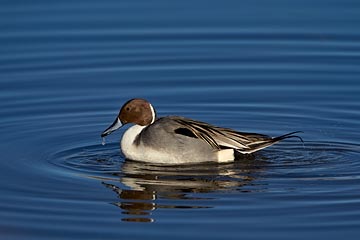
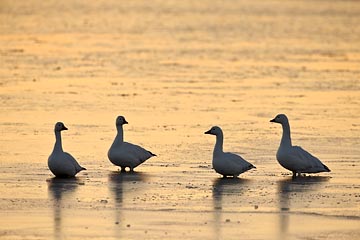
Travel: San Juan Mountains of Colorado
I spent about a week in early January in the San Juan Mountains of Southwestern Colorado to photograph winter scenes. The weather didn't cooperate for grand landscapes so I focused my attention on smaller scenes.
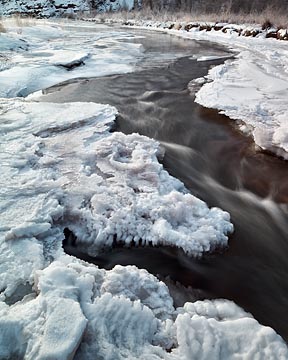

One of my favorite subjects was the frozen San Miguel River that I photographed several times (above left and below left). Even the grass was more exciting than the majestic mountains while I was there (above right).
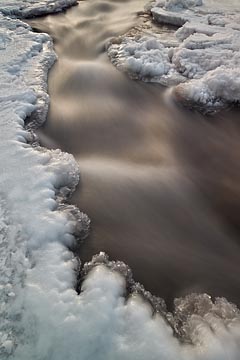
LBW polarizer, 7-stop ND,
10 sec, f13, ISO 100
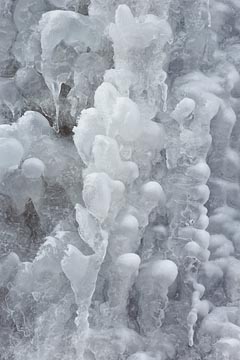
1/4 sec, f13, ISO 100
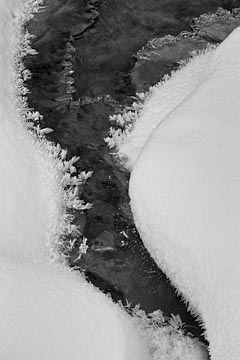
1/10 sec, f11, ISO 100
Ice can take many forms, and I was drawn to the stalactite-like formations on a cliff face under a small waterfall (above center). The ice along Deep Creek formed feather-like formations (above right).
Travel: Grand Teton National Park, Wyoming
I spent four nights in Grand Teton National Park in early January, and that's as long as the propane could last in my RV with lows between 5°F (-15°C) and -20°F (-29°C) and highs between 5°F (-15°C) and 20°F (-6°C). One afternoon when I left the RV to go photograph, a Red Fox was wandering around nearby and of course I had to photograph it. It was almost too friendly because every time I got in a good position to photograph it, it started coming towards me. When I'd stand up to move back, it would move back too then start coming towards me again when I was ready to photograph it. I made this tight portrait (below left) on one of its close approaches. It snowed on my first two days there, and the fresh snow cover was perfect for landscape photography when the storm cleared. The clouds didn't cooperate for grand landscape images, but I like the cold feeling in this image of the Teton Range at dawn (below center). One afternoon I had a ball photographing small details in the snow like this sagebrush bush (below right).
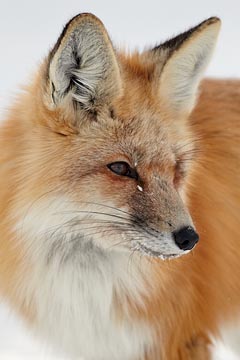
1/500 sec, f8, ISO 400
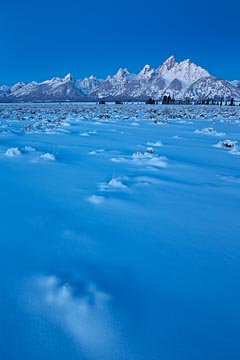
3 sec, f8, ISO 100
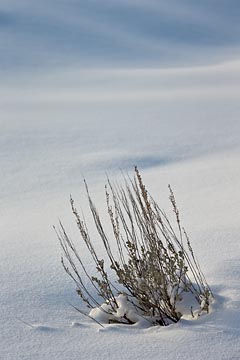
(at 168mm), 1/90 sec, f13, ISO 100
I found this Elk calf one morning on a small rise and loved the way it stood out backlit against the dark background. Another morning this Moose cow and calf followed me for about 40 minutes. I came upon the moose near the main highway in the park, US-89, which runs roughly northeast and southwest. They were on the west side of the highway heading southwest — perfect lighting conditions. I set up to photograph them from the car, and when they came too close I backed up and shot some more. I continued doing this until they decided to cross the road. While I got some nice images early on, and it would have been easy to leave them, I stuck with them until they decided to leave, and this image was taken near the end of our encounter.
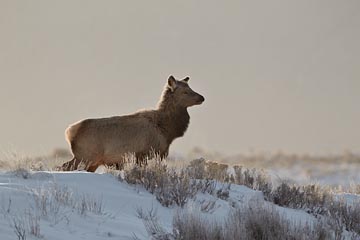
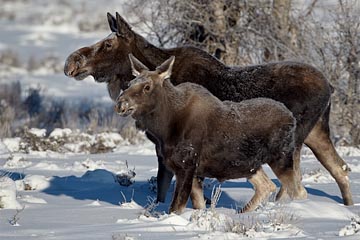
Travel: Yellowstone National Park, Wyoming
I spent a week in Yellowstone National Park in the middle of January, and it reached a balmy 35°F (2°C) a couple of days. The snow was still fresh early in my stay and the animals were fairly cooperative. This Coyote was running along the side of the road and I quickly set up to photograph it as it crested a small rise (below left). I was able to take advantage of some colorful sunrises and sunsets with Elk on the horizon, including this bull Elk at sunset (below right).
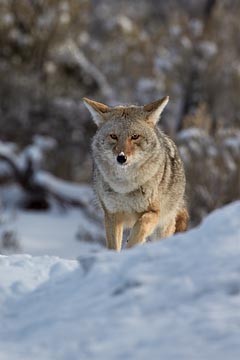
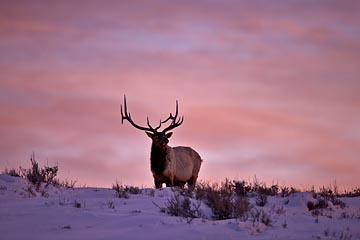
One of my favorite small subjects in Yellowstone is the American Dipper or Water Ouzel. They seemed more plentiful this year, probably because large stretches of the Lamar River and Soda Butte Creek were completely frozen over so they were forced to congregate in a smaller area where there was open water. You see, dippers feed by standing by the side of a stream or river and look for insect larva, or small crayfish, to go by. When they see a potential prey item, they dive right in and grab it. I photographed this one (below left) shortly after it popped up out of the water with some prey in its beak.
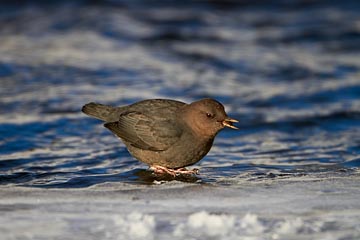
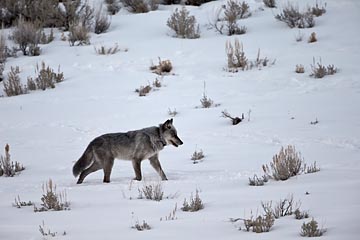
The highlight of my stay was watching and photographing a Gray Wolf. After I crested a hill early in the morning, I saw a canid in the distance very close to the road and heading away like it had recently crossed the road. Because coyotes are more common to see up close than wolves, I immediately thought it was a coyote. As I kept watching it as I got closer, it didn't quite look like a coyote. Then it hit me: it's a wolf! I quickly set up to shoot from the car because encountering a wolf 50 yds (45m) away is very rare. It was wolf 755M, the alpha male of the Lamar Canyon Pack, sporting a new radio collar. It started paralleling the road, about 50 to 75 yds (45 to 70m) out, and I stayed ahead of it photographing it whenever it was in a good location. After a while, 755M started moving further and further from the road so I left, extremely excited to have had that 35 minutes or so in close proximity to a wolf in the wild going about his business.
Travel: Tanzania
At the beginning of February, I led a two-week photo safari to Tanzania, and it was a resounding success! We spent four days in Ngorongoro Crater and ten days in Serengeti National Park and had much better than average opportunities with Black Rhinocerous, Caracal, Cheetah, and Leopard. Yes, Caracal. It's unusual to even see a Caracal on safari, but we saw four and photographed two!
Our first good photo opportunity for Black Rhino was of not one but two rhinos! They were posturing and would periodically get into nice alignment (below left). One of my favorite images from the safari is of this Warthog standing on a nice rise in short grass at first light (below right).
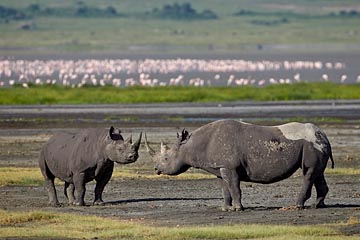
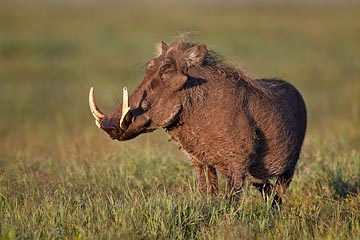
The highlight of the safari for me was spending some time with a Caracal. First we photographed her posing and hunting, then carrying the Nile Grass Rat that she had caught (below left). Yes, it's a female because shortly after I made this image she started calling her cub and eventually we were able to photograph it through tall grass. While the images of the cub aren't that exciting, it sure was exciting to see my first ever Caracal cub!
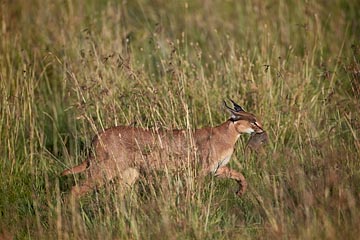
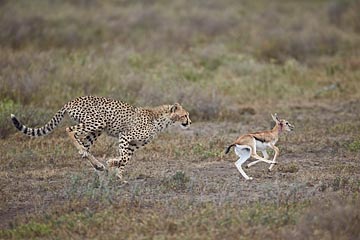
We also had exceptional photo ops with Cheetah, especially of a mother with four older cubs. She was a good mother to still have four cubs because most only successfully raise two or three. The first morning we spent with them, we started off getting nice portrait images as they were grooming and leisurely looking for prey. When they switched to hunting mode, we backed off and set up for the chase and hopefully the kill. The mother took down a baby Thomson's Gazelle but just held it until the cubs arrived. Then she let the gazelle go and the cubs practiced hunting as shown in the image above right. The cubs still have a lot to learn because as soon as the gazelle was knocked to the ground and wasn't moving, they lost interest. But as soon as it got back up and started running, they were after it again. The next afternoon, we had a great opportunity to photograph the mother take down a male Thomson's Gazelle.
The Central Serengeti is usually good for Leopard, and we had a great opportunity to photograph a male after he had caught a young Warthog and carried the carcass back to, and then up into, his favorite tree. In the image below left, he's pausing to rest at the fork in the trunk before carrying the carcass up into the dense canopy.
We had a lot of fun one morning photographing a troupe of Olive Baboons. After following them for a while, this mother paused to let her infant nurse (below center). Grey Crowned Cranes are usually quite shy, so I was surprised when we were able to practically drive right up to this one (below right). It gave us several good looks before calmly walking away.
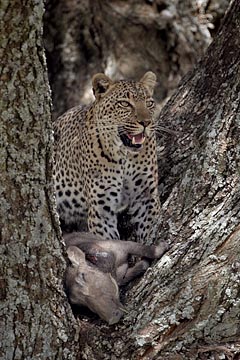
1/350 sec, f5.6, ISO 400
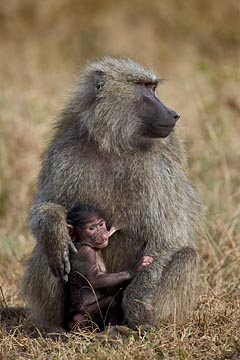
1/1000 sec, f5.6, ISO 320
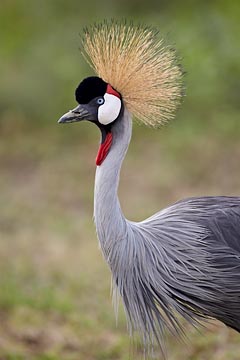
1/1000 sec, f5.6, ISO 320
Black-Shouldered Kites can be skittish, so we tried to photograph them whenever possible. This one let us approach fairly close and I got some nice portrait images before it had enough of the paparazzi and took off (below left). We spent some of time at a Zebra carcass late one morning where lots of vultures were feeding. This Rüppell's Griffon Vulture was late to the party, but I loved photographing his arrival (below right).
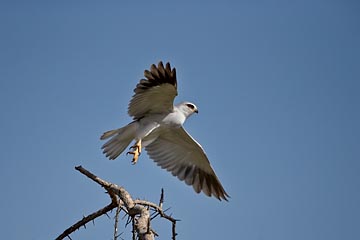
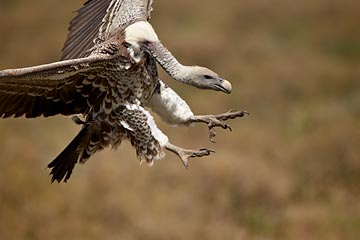
I'll tell you all about South Africa in the next Newsletter.
Until then, take care and happy shooting.
— James
James Hager Photography :: www.jameshagerphoto.com




